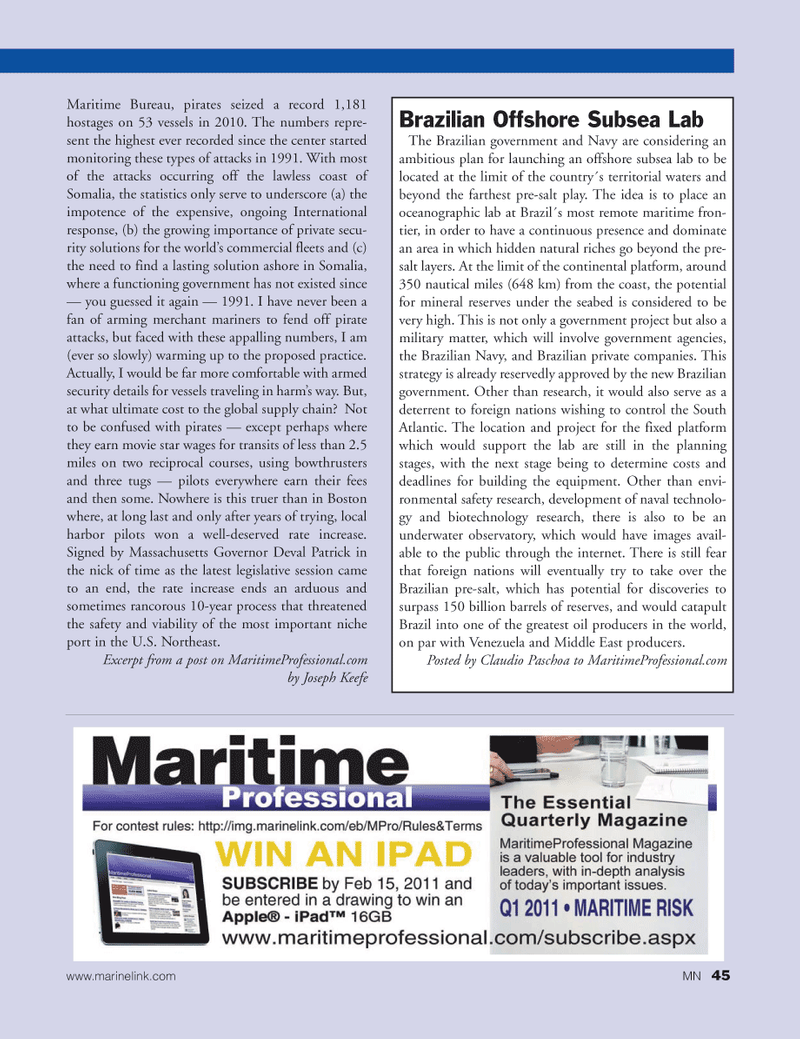
Page 45: of Marine News Magazine (February 2011)
Inland Waterways
Read this page in Pdf, Flash or Html5 edition of February 2011 Marine News Magazine
www.marinelink.com MN 45
Maritime Bureau, pirates seized a record 1,181 hostages on 53 vessels in 2010. The numbers repre- sent the highest ever recorded since the center started monitoring these types of attacks in 1991. With most of the attacks occurring off the lawless coast of
Somalia, the statistics only serve to underscore (a) the impotence of the expensive, ongoing International response, (b) the growing importance of private secu- rity solutions for the world’s commercial fleets and (c) the need to find a lasting solution ashore in Somalia, where a functioning government has not existed since — you guessed it again — 1991. I have never been a fan of arming merchant mariners to fend off pirate attacks, but faced with these appalling numbers, I am (ever so slowly) warming up to the proposed practice.
Actually, I would be far more comfortable with armed security details for vessels traveling in harm’s way. But, at what ultimate cost to the global supply chain? Not to be confused with pirates — except perhaps where they earn movie star wages for transits of less than 2.5 miles on two reciprocal courses, using bowthrusters and three tugs — pilots everywhere earn their fees and then some. Nowhere is this truer than in Boston where, at long last and only after years of trying, local harbor pilots won a well-deserved rate increase.
Signed by Massachusetts Governor Deval Patrick in the nick of time as the latest legislative session came to an end, the rate increase ends an arduous and sometimes rancorous 10-year process that threatened the safety and viability of the most important niche port in the U.S. Northeast.
Excerpt from a post on MaritimeProfessional.com by Joseph Keefe
Brazilian Offshore Subsea Lab
The Brazilian government and Navy are considering an ambitious plan for launching an offshore subsea lab to be located at the limit of the country´s territorial waters and beyond the farthest pre-salt play. The idea is to place an oceanographic lab at Brazil´s most remote maritime fron- tier, in order to have a continuous presence and dominate an area in which hidden natural riches go beyond the pre- salt layers. At the limit of the continental platform, around 350 nautical miles (648 km) from the coast, the potential for mineral reserves under the seabed is considered to be very high. This is not only a government project but also a military matter, which will involve government agencies, the Brazilian Navy, and Brazilian private companies. This strategy is already reservedly approved by the new Brazilian government. Other than research, it would also serve as a deterrent to foreign nations wishing to control the South
Atlantic. The location and project for the fixed platform which would support the lab are still in the planning stages, with the next stage being to determine costs and deadlines for building the equipment. Other than envi- ronmental safety research, development of naval technolo- gy and biotechnology research, there is also to be an underwater observatory, which would have images avail- able to the public through the internet. There is still fear that foreign nations will eventually try to take over the
Brazilian pre-salt, which has potential for discoveries to surpass 150 billion barrels of reserves, and would catapult
Brazil into one of the greatest oil producers in the world, on par with Venezuela and Middle East producers.
Posted by Claudio Paschoa to MaritimeProfessional.com

 44
44

 46
46
